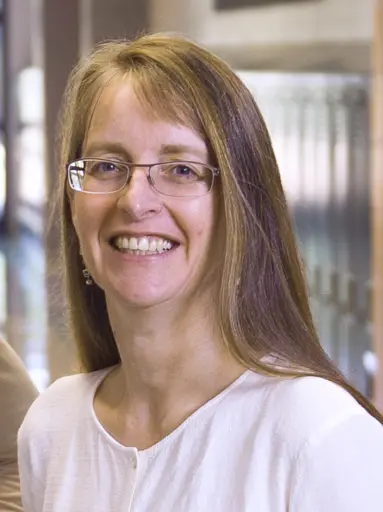Imagine an abundant energy source that could power the world without harming the environment.
Fusion energy—the same powerful reactions that keep stars burning—could provide a completely renewable alternative to fossil fuels while being much more reliable than solar or wind. What’s more, fusion power plants will not emit greenhouse gasses nor produce long-lived radioactive waste.
 Amy Wendt
Amy Wendt
“Fusion energy as a clean and viable energy source will have a huge impact on our society,” says Amy Wendt, a professor of electrical and computer engineering at the University of Wisconsin-Madison.
Wendt is shaping the future of fusion energy research in the United States as one of 19 leaders of a National Academies of Science, Engineering and Medicine committee to develop a strategic plan for U.S. burning plasma research. Since 2017, the university researchers, government scientists and industry representatives have been attending meetings and gathering information for recommendations on U.S. strategy to realize fusion energy for electricity production by mid-century. UW-Madison is well-represented on the committee, as Wendt is joined by Cary Forest, a professor of physics.
To eventually achieve fusion energy, scientists have set their sights on burning plasmas, similar to the hot ionized gases found in stars. The most promising approach to harnessing burning plasmas is known as magnetic confinement fusion, where tremendously high temperatures combined with enormous amounts of compression causes atoms to start fusing, so that the energy released from those fusion reactions is enough to sustain the plasma without further external energy input.
The easiest path to fusion makes use of isotopic forms of hydrogen as the fuel, with helium formed as the fusion product. Magnetic fields produced by currents in the plasma and in exquisitely designed external magnet coils contain and compress the plasma until fusion begins.
But containing and compressing those hot ionized gases is anything but easy.
“It’s like taking a lump of Jello and trying to compress it with your hands—it wants to squirt out between your fingers,” says Wendt.
And that lump of Jello is at a temperature roughly 10 times hotter than the core of the sun.
Burning plasmas have not yet been sustained long enough to be a viable power source here on Earth. Even though plasma scientists have identified clear pathways to achieve that goal, a cost-effective power plant requires better understanding of how burning plasmas behave, as well as further development and testing of new technologies needed to fuel the sustained plasma and to collect the excess energy it produces.
Efforts are currently underway to build a burning plasma facility in the south of France, under the auspices of an international collaboration called the ITER organization. When completed, the ITER machine will weigh more than 23,000 tons, and the donut-shaped burning plasma confinement chamber will be more than six stories tall.
“It’s hard to convey the enormity of this construction project. It’s fantastically huge and complex and there’s a lot of new technology,” says Wendt. “When you’re standing in the room where the plasma chamber will be located, it’s like you’re in a Roman coliseum.”
The United states contributes machine components and financial support to the endeavor, and UW-Madison faculty, including nuclear engineering and engineering physics professors Ray Fonck, Paul Wilson and Oliver Schmitz, among others, have devoted their expertise to ITER over the decades.
Wilson, for example, was instrumental in developing software tools to measure radiation levels in the facility and Schmitz performed sophisticated modeling experiments to predict how the burning plasma will behave once ITER turns on.
ITER marked a major milestone in 2017 when it reached the halfway point for its construction. The facility should be up and running by 2025.
The National Academies committee issued a preliminary report in December 2017 that identified burning plasma experiments as necessary steps toward fusion power. Wendt, along with the other committee members, visited the ITER construction site in February 2018 as part of their evaluation of whether the United States should continue participating in the international collaboration or consider launching an independent burning plasma research effort.
The committee’s preliminary report emphasized the potential benefits to the U.S. of combining scientific and engineering expertise through international collaboration if it remains a full partner. For example, supporting burning plasma experiments can help boost our country’s overall industrial capabilities by advancing research in materials science, superconducting magnets, cryogenic cooling systems, ultra-precise construction, and robotic manufacturing.
The committee will make detailed recommendations a final report to be released in September 2018.
Even after the ITER burning plasma facility switches on in 2025, advances in many disciplines will be necessary to build a full-fledged fusion power plant. which is another reason why Wendt and the committee were invited to make recommendations on a long-term strategic plan for the United States.
“Fusion power on the electric grid is something that I will not see in my lifetime, but the potential benefit to humanity is incalculable. I think there’s a human drive to create these things that are bigger than ourselves, and in this case it is to meet a societal need,” says Wendt.
While visiting the ITER construction site, Wendt took a side trip to Paris where she marveled at the beauty and history of the Notre Dame Cathedral. Although French Gothic architecture shares few construction materials in common with burning plasma confinement chambers, Wendt was struck by connections between the labor of medieval artisans and that of present-day fusion researchers.
“The cathedrals were conceived by people with a vision powerful enough to sustain the construction over the lifetimes of many generations of contributors,” says Wendt.